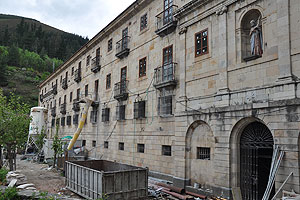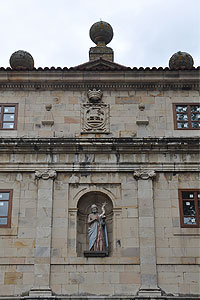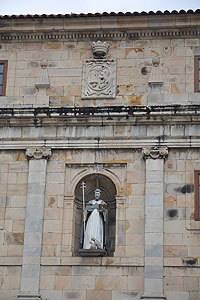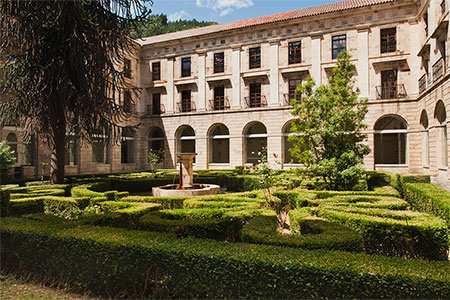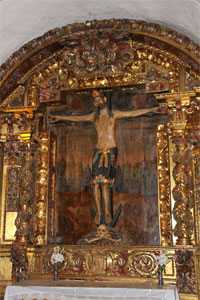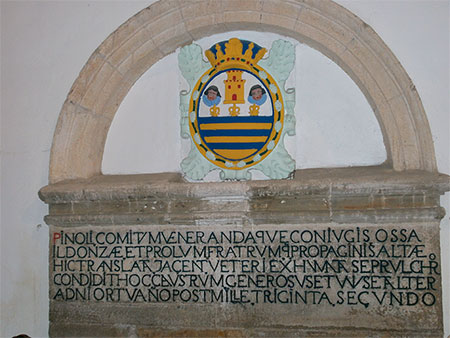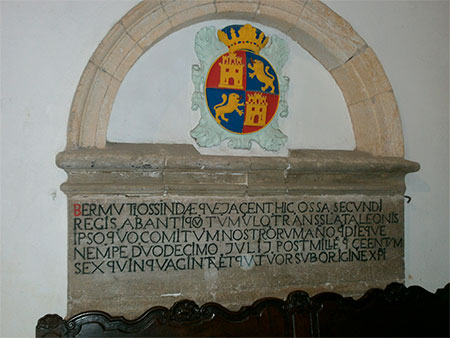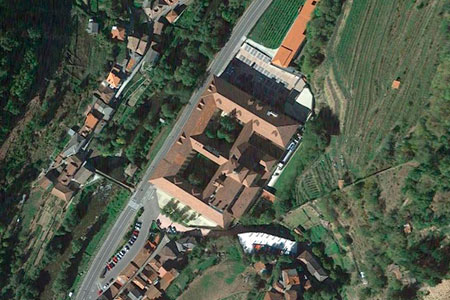Monastery of San Juan de Corias
Monasterio de Corias / Monasterium Coriense
(Cangas del Narcea, Asturias)
This is an old Benedictine monastery founded by a notable court figure, Count Piniolo Jiménez († 1049), together with his wife Aldonza Muñoz († 1063). It is believed that, due to the lack of living descendants, the counts decided to establish this house, which they endowed with their considerable wealth. Later, a miraculous origin was attributed to the story of this foundation. In 1031, King Bermudo III of León also intervened, donating to the founders the land where the monastery was to be built.
By 1043, a provisional church had already been erected, and Abbot Arias was appointed to lead the newly established community. Later, a new church was constructed. In 1046, King Ferdinand I granted a charter to the monastery, giving it lordship and jurisdictional control over that territory. The priory of San Miguel de Bárcena, previously founded by members of the same family, was dependent on this monastery. The first church, with a single nave and a transept where three apses opened, had a funerary purpose and was dedicated to Santa María. Among others, the tombs of the founders were located there, and possibly that of King Bermudo I of Asturias († 797).
The second, larger church was dedicated to San Juan Bautista and was consecrated in 1113. For many years, both constructions coexisted. The Corias monastery became an establishment of considerable importance, despite opposition and differences with other institutions and power centers. The conflicts were significant, and even in 1211, Pope Innocent III intervened. Matters worsened during the 13th and 14th centuries, with actions contrary to proper monastic observance. A bishop's visitation in 1380 reveals that state of affairs. By the end of the 15th century, the house began to be governed by commendatory abbots, until it became part of the Congregation of San Benito of Valladolid in 1536.
The connection with this congregation led to a new period of prosperity, reflected in the reconstruction of the monastery at the end of the 16th century. In 1763, the site was heavily affected by a fire and had to be rebuilt again between 1774 and 1808. The Benedictine community came to an end with the confiscation of Mendizábal of 1835, when the monks left the monastery. The site had several uses until, in 1860, it was taken over by a Dominican community. More recently, in 2002, the large monastic house was acquired by the regional government with the aim of converting it into a hotel, a project carried out between 2007 and 2013, when an archaeological study of the site was also completed.
- CUERVO, Dr. Fray Justo (1915). El Monasterio de San Juan de Corias. Salamanca: Imprenta Católica
- FERNÁNDEZ GARCÍA, Noelia (2022). La refundación del Monasterio de San Juan Bautista de Corias y su integración en la red de paradores. Estudios Turísticos, núm. 224
- GARCÍA ÁLVAREZ-BUSTO, Alejandro (2012). La iglesia fundacional del monasterio de Corias (Asturias) y los orígenes de la arquitectura monástica benedictina en el noroeste de la Península Ibérica. Pyrenae, núm. 43
- GARCÍA ÁLVAREZ-BUSTO, Alejandro (2012). La topografía funeraria del monasterio de Corias en la época medieval a partir de la arqueología y las fuentes escritas. Territorio, Sociedad y Poder, núm. 7
- GARCÍA ÁLVAREZ-BUSTO, Alejandro (2013). Evolución arquitectónica del monasterio de San Juan Bautista de Corias. Excavaciones arqueológicas en Asturias 2007-2012. Consejería de Educación, Cultura y Deporte
- GARCÍA ÁLVAREZ-BUSTO, Alejandro (2016). Arqueología de la arquitectura monástica en Asturias. San Juan Bautista de Corias. Consejería de Educación y Cultura
- GARCÍA ÁLVAREZ-BUSTO, Alejandro; ed. (2020). Asturias monástica. Catálogo de monasterios y revisión histórica arqueológica (siglos XI-XIX). Vol. 1. Anejos de Nailos n.º 7. Ovedo: KRK Ed.
- GARCÍA GUINEA, Miguel Ángel; dir. (2006). Enciclopedia del Románico en Asturias. Aguilar de Campoo. Fundación Santa María la Real
- MARTÍNEZ VEGA, Andrés (2011). Monasterios medievales de Asturias. Oviedo: Cajastur, 2011
- RISCO, Fray Manuel (1793). España Sagrada, Oviedo, vol. 38. Madrid: B. Román
- YEPES, Fray Antonio de (1960). Crónica General de la orden de San Benito. Madrid: Atlas


